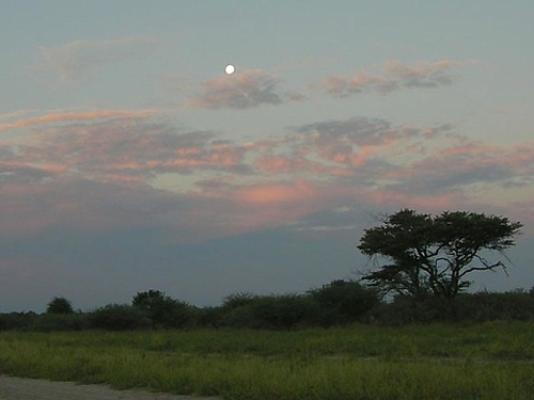

The Central Kalahari Game Reserve is the second largest game reserve in the world encompassing 52 800 sq kms. Situated right in the centre of Botswana, this reserve is characterised by vast open plains, saltpans and ancient riverbeds.
Varying from sand dunes with many species of trees and shrubs in the north, to flat bushveld in the central area, the reserve is more heavily wooded in the south, with mophane forests to the south and east. Rainfall is sparse and sporadic and can vary from 70 to 170 millimetres per year.
The main wildlife concentrations are to be found in the tourist areas in the northern half of this vast reserve. Game like giraffe, brown hyena, warthog, cheetah, wild dog, leopard, lion, blue wildebeest, eland, gemsbok, kudu, red hartebeest and springbok can be viewed. It is best between December and April, when the animals congregate in the pans and valleys.
The Basarwa or San people, have been resident in and around this area for probably thousands of years. Originally nomadic hunters and gathers, the lifestyle of the Basarwa has gradually changed with the times and they now live in settlements, some of which are situated within the southern half of the Central Kalahari Game Reserve.
Visitors should note that, apart from being self-contained with all fuel, food and water, they should only travel in a group of two or more vehicles with basic spares and survival aids.
Accommodation
View options for Accommodation in the Central Kalahari Game Reserve.
Apart for the few lodges, there are only undeveloped public camping sites within the Central Kalahari. Matswere is the access point for designated but undeveloped campsites in the region of Deception Valley, Sunday Pan, Leopard Pan and Passage Valley.
Visitors dig their own mini-latrine to ensure they leave no signs of being there, particularly where toilet paper is concerned. Firewood may be collected from well-wooded areas but not from tree islands. The ashes from campfires must be buried before vacating a campsite, combustible rubbish burnt and non-combustibles carried back to the pit at the entrance gate.
Water for purposes other than drinking is available from the Wildlife Camp at Xade and at the Matswere entrance gate/tourist office.
How to get there
There are three entry points to the reserve, through Khutse in the south, a western entrance through Xade and in the northeast through Matswere.
The best entrance into the northern more game-rich part of the Park is through Matswere. Access to Matswere can be made via Rakops which is 55 kilometres from the check-in point at Matswere. Rakops can be accessed from either the north from Maun (via Motopi, Kumaga and Tsoe) or from the south from Mahalapye (via Serowe, Letlhakane and Mopipi).
Access to Xade to the central part of the Park, where there are two undeveloped campsites near the Xade Wildlife Camp, is made by turning off east from the Ghanzi-Kang road about 36 kilometres south of Ghanzi where indicated by signpost. Xade is reached after following this loose sandy track for 160 kilometres, taking about three hours for the full journey from Ghanzi.


